Paper Menu >>
Journal Menu >>
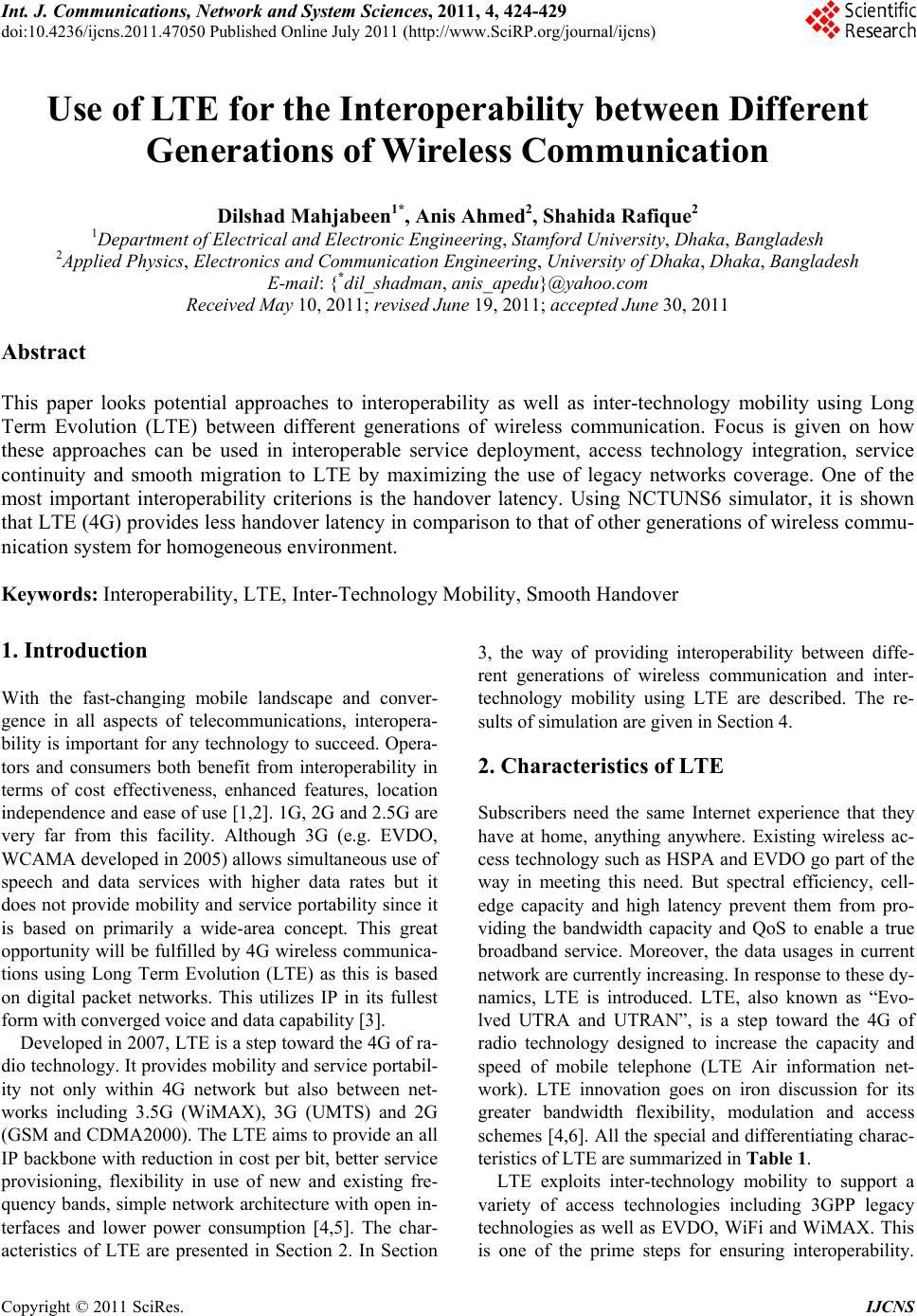 Int. J. Communications, Network and System Sciences, 2011, 4, 424-429 doi:10.4236/ijcns.2011.47050 Published Online July 2011 (http://www.SciRP.org/journal/ijcns) Copyright © 2011 SciRes. IJCNS Use of LTE for the Interoperability between Different Generations of Wireless Communication Dilshad Mahjabeen1*, Anis Ahmed2, Shahida Rafique2 1Department of Electrical and Electron ic Engineering, Stamford University, Dhaka, Bangladesh 2Applied Physics, Electronics and Communication Engineering, University of Dhaka, Dhaka, Bangladesh E-mail: {*dil_shadman, anis_apedu}@yahoo.com Received May 10, 2011; revised June 19, 2011; accepted June 30, 2011 Abstract This paper looks potential approaches to interoperability as well as inter-technology mobility using Long Term Evolution (LTE) between different generations of wireless communication. Focus is given on how these approaches can be used in interoperable service deployment, access technology integration, service continuity and smooth migration to LTE by maximizing the use of legacy networks coverage. One of the most important interoperability criterions is the handover latency. Using NCTUNS6 simulator, it is shown that LTE (4G) provides less handover latency in comparison to that of other generations of wireless commu- nication system for homogeneous environment. Keywords: Interoperability, LTE, Inter-Technology Mobility, Smooth Handover 1. Introduction With the fast-changing mobile landscape and conver- gence in all aspects of telecommunications, interopera- bility is important for any technology to succeed. Opera- tors and consumers both benefit from interoperability in terms of cost effectiveness, enhanced features, location independence and ease of use [1,2]. 1G, 2G and 2.5G are very far from this facility. Although 3G (e.g. EVDO, WCAMA developed in 2005) allows simultaneous use of speech and data services with higher data rates but it does not provide mobility and service portability since it is based on primarily a wide-area concept. This great opportunity will be fulfilled by 4G wireless communica- tions using Long Term Evolution (LTE) as this is based on digital packet networks. This utilizes IP in its fullest form with converged voice and data capability [3]. Developed in 2007, LTE is a step toward the 4G of ra- dio technology. It provides mobility and serv ice portabil- ity not only within 4G network but also between net- works including 3.5G (WiMAX), 3G (UMTS) and 2G (GSM and CDMA2000) . The LTE aims to provid e an all IP backbone with reduction in cost per b it, better service provisioning, flexibility in use of new and existing fre- quency bands, simple network architecture with open in- terfaces and lower power consumption [4,5]. The char- acteristics of LTE are presented in Section 2. In Section 3, the way of providing interoperability between diffe- rent generations of wireless communication and inter- technology mobility using LTE are described. The re- sults of simulation are given in Section 4. 2. Characteristics of LTE Subscribers need the same Internet experience that they have at home, anything anywhere. Existing wireless ac- cess technology such as HSPA and EVDO go part of the way in meeting this need. But spectral efficiency, cell- edge capacity and high latency prevent them from pro- viding the bandwidth capacity and QoS to enable a true broadband service. Moreover, the data usages in current network are currently increasin g. In respon se to th ese dy- namics, LTE is introduced. LTE, also known as “Evo- lved UTRA and UTRAN”, is a step toward the 4G of radio technology designed to increase the capacity and speed of mobile telephone (LTE Air information net- work). LTE innovation goes on iron discussion for its greater bandwidth flexibility, modulation and access schemes [4,6]. All the special and differentiating charac- teristics of LTE are summarized in Table 1. LTE exploits inter-technology mobility to support a variety of access technologies including 3GPP legacy technologies as well as EVDO, WiFi and WiMAX. This is one of the prime steps for ensuring interoperability. 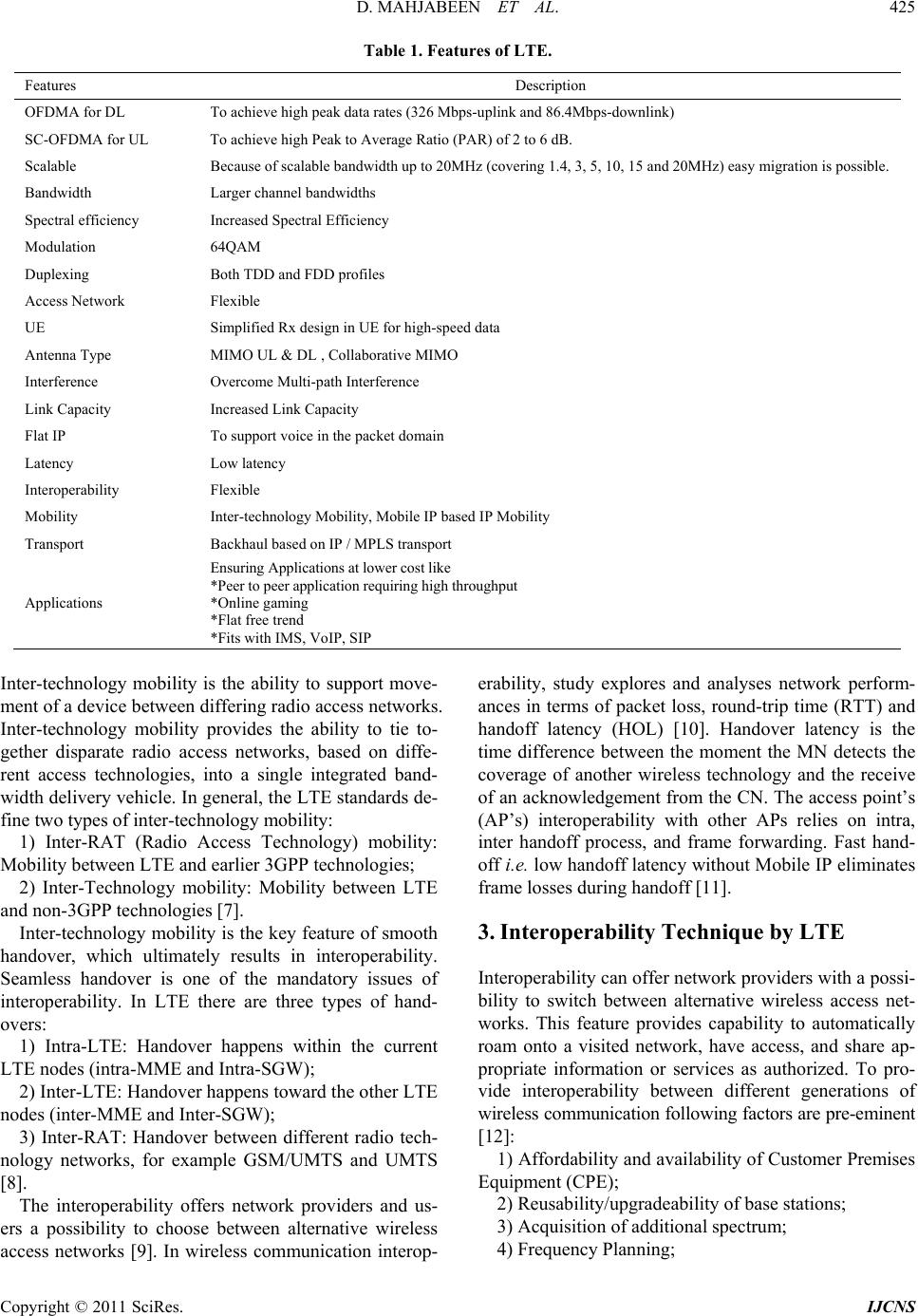 D. MAHJABEEN ET AL. Copyright © 2011 SciRes. IJCNS 425 Table 1. Features of LTE. Features Description OFDMA for DL To achieve high peak data rates (326 Mbp s -uplink and 86.4Mbps-downlink) SC-OFDMA for UL To achieve high Peak to Average Ratio (PAR) of 2 to 6 dB. Scalable Because of scalable bandwidth up to 20MHz (covering 1.4, 3, 5, 10, 15 and 20MHz) easy migration is possible. Bandwidth Larger channel bandwidths Spectral efficiency Increased Spectral Efficiency Modulation 64QAM Duplexing Both TDD and FDD profiles Access Network Flexible UE Simplified Rx design in UE for high-speed da ta Antenna Type MIMO UL & DL , Collaborative MIMO Interference Overcome Multi-path Interference Link Capacity Increased Link Capacity Flat IP To support voice in the packet domain Latency Low latency Interoperability Flexible Mobility Inter-technology Mobility, Mobile IP based IP Mobility Transport Backhaul based on IP / MPLS transport Applications Ensuring Applications at lower cost like *Peer to peer application requiring high throughput *Online gaming *Flat free trend *Fits with IMS, VoIP, SIP Inter-technology mobility is the ability to support move- ment of a device between differing radio access networks. Inter-technology mobility provides the ability to tie to- gether disparate radio access networks, based on diffe- rent access technologies, into a single integrated band- width delivery vehicle. In general, the LTE standards de- fine two types of inter-technology mobility: 1) Inter-RAT (Radio Access Technology) mobility: Mobility between LTE and earlier 3GPP technologies; 2) Inter-Technology mobility: Mobility between LTE and non-3GPP technologies [7]. Inter-technology mobility is the k ey feature of smooth handover, which ultimately results in interoperability. Seamless handover is one of the mandatory issues of interoperability. In LTE there are three types of hand- overs: 1) Intra-LTE: Handover happens within the current LTE nodes (intr a-M ME a nd Intra-SGW); 2) Inter-LTE: Handover happens toward the other LTE nodes (inter-MME and Inter-SGW); 3) Inter-RAT: Handover between different radio tech- nology networks, for example GSM/UMTS and UMTS [8]. The interoperability offers network providers and us- ers a possibility to choose between alternative wireless access networks [9]. In wireless communication interop- erability, study explores and analyses network perform- ances in terms of packet loss, round-trip time (RTT) and handoff latency (HOL) [10]. Handover latency is the time difference between the moment the MN detects the coverage of another wireless technology and the receive of an acknowledgement from the CN. The access point’s (AP’s) interoperability with other APs relies on intra, inter handoff process, and frame forwarding. Fast hand- off i.e. low handoff latency without Mob ile IP eliminates frame losses during handoff [11]. 3. Interoperability Technique by LTE Interoperability can offer network provid ers with a possi- bility to switch between alternative wireless access net- works. This feature provides capability to automatically roam onto a visited network, have access, and share ap- propriate information or services as authorized. To pro- vide interoperability between different generations of wireless communication following factors ar e pre-eminent [12]: 1) Affordabilit y and availability of Cu stomer Premises Equipment (CPE); 2) Reusability/u pgradeability of base stations; 3) Acquisition of additional spectrum; 4) Frequency Planning; 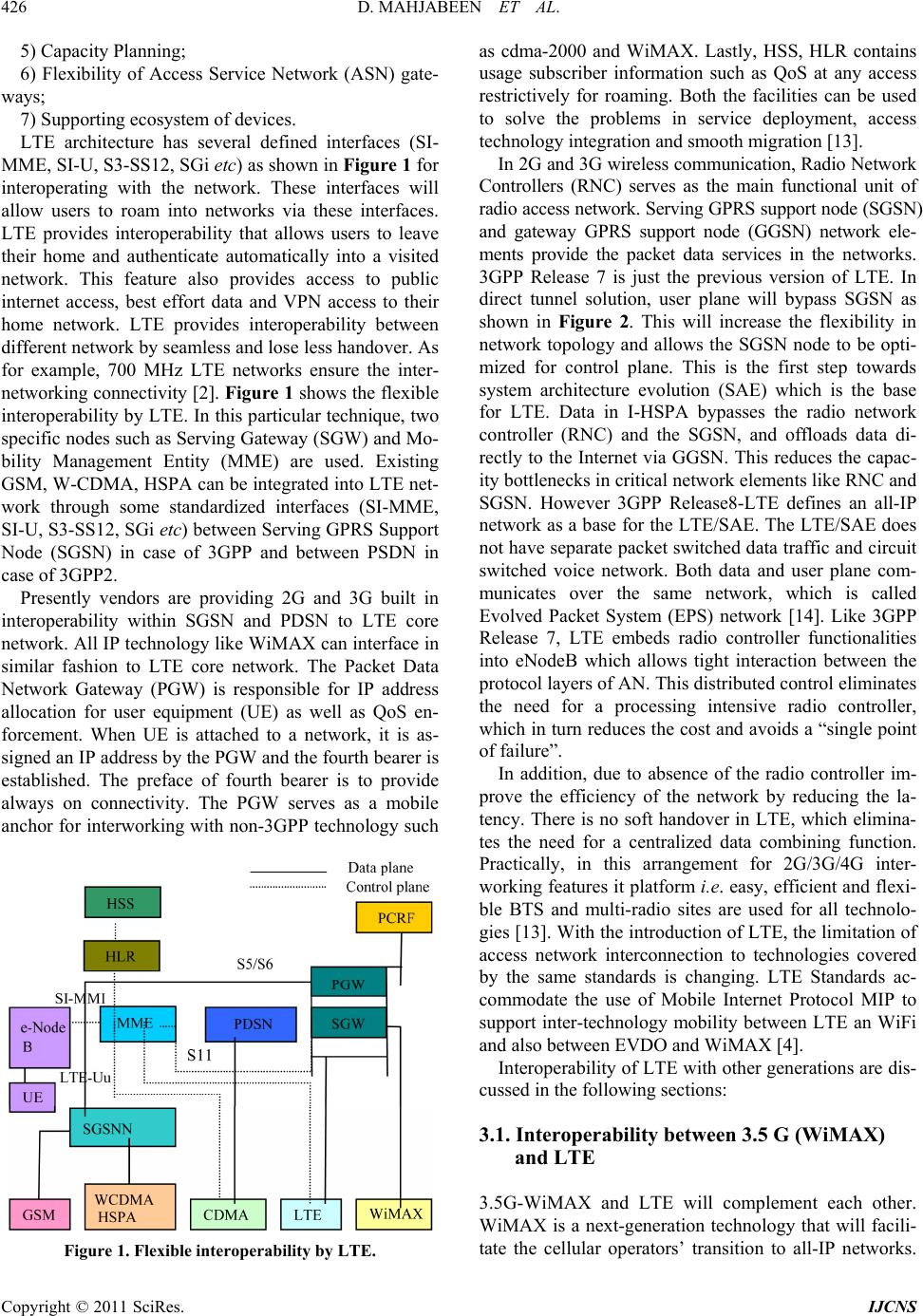 D. MAHJABEEN ET AL. Copyright © 2011 SciRes. IJCNS 426 5) Capacity Planning; 6) Flexibility of Access Service Network (ASN) gate- ways; 7) Supporting ecosystem of devices. LTE architecture has several defined interfaces (SI- MME, SI-U, S3-SS12, SGi etc) as shown in Figure 1 for interoperating with the network. These interfaces will allow users to roam into networks via these interfaces. LTE provides interoperability that allows users to leave their home and authenticate automatically into a visited network. This feature also provides access to public internet access, best effort data and VPN access to their home network. LTE provides interoperability between different network by seamless and lose less handover. As for example, 700 MHz LTE networks ensure the inter- networking connectivity [2]. Figure 1 shows the flexible interoperability by LTE. In this particular techn ique, two specific nodes such as Serving Gateway (SGW) and Mo- bility Management Entity (MME) are used. Existing GSM, W-CDMA, HSPA can be integrated into LTE net- work through some standardized interfaces (SI-MME, SI-U, S3-SS12, SGi etc) between Serving GPRS Support Node (SGSN) in case of 3GPP and between PSDN in case of 3GPP2. Presently vendors are providing 2G and 3G built in interoperability within SGSN and PDSN to LTE core network. All IP technology like WiMAX can interface in similar fashion to LTE core network. The Packet Data Network Gateway (PGW) is responsible for IP address allocation for user equipment (UE) as well as QoS en- forcement. When UE is attached to a network, it is as- signed an IP address by the PGW and the fourth bearer is established. The preface of fourth bearer is to provide always on connectivity. The PGW serves as a mobile anchor for interworking with non-3GPP technology such Figure 1. Flexible interoperability by LTE. as cdma-2000 and WiMAX. Lastly, HSS, HLR contains usage subscriber information such as QoS at any access restrictively for roaming. Both the facilities can be used to solve the problems in service deployment, access technology integration and smooth migration [13]. In 2G and 3G wireless communication, Radio Network Controllers (RNC) serves as the main functional unit of radio access network. Serving GPRS support node (SGSN) and gateway GPRS support node (GGSN) network ele- ments provide the packet data services in the networks. 3GPP Release 7 is just the previous version of LTE. In direct tunnel solution, user plane will bypass SGSN as shown in Figure 2. This will increase the flexibility in network topology and allows the SGSN node to be opti- mized for control plane. This is the first step towards system architecture evolution (SAE) which is the base for LTE. Data in I-HSPA bypasses the radio network controller (RNC) and the SGSN, and offloads data di- rectly to the Internet via GGSN. This reduces the capac- ity bottlenecks in critical network elements like RNC and SGSN. However 3GPP Release8-LTE defines an all-IP network as a base for the LTE/SAE. The LTE/SAE does not have separate packet switched data traffic and circuit switched voice network. Both data and user plane com- municates over the same network, which is called Evolved Packet System (EPS) network [14]. Like 3GPP Release 7, LTE embeds radio controller functionalities into eNodeB which allows tight interaction between the protocol layers of AN. This distributed control eliminates the need for a processing intensive radio controller, which in turn reduces the cost and avoids a “single point of failure”. In addition, due to absence of the radio controller im- prove the efficiency of the network by reducing the la- tency. There is no soft handover in LTE, which elimina- tes the need for a centralized data combining function. Practically, in this arrangement for 2G/3G/4G inter- working features it platform i.e. easy, efficient and flexi- ble BTS and multi-radio sites are used for all technolo- gies [13]. With the introduction of LTE, the limitation of access network interconnection to technologies covered by the same standards is changing. LTE Standards ac- commodate the use of Mobile Internet Protocol MIP to support inter-technology mobility between LTE an WiFi and also between EVDO and WiMAX [4]. Interoperability of LTE with other generations are dis- cussed in the following sections: 3.1. Interoperability between 3.5 G (WiMAX) and LTE 3.5G-WiMAX and LTE will complement each other. WiMAX is a next-generation technology that will facili- tate the cellular operators’ transition to all-IP networks. 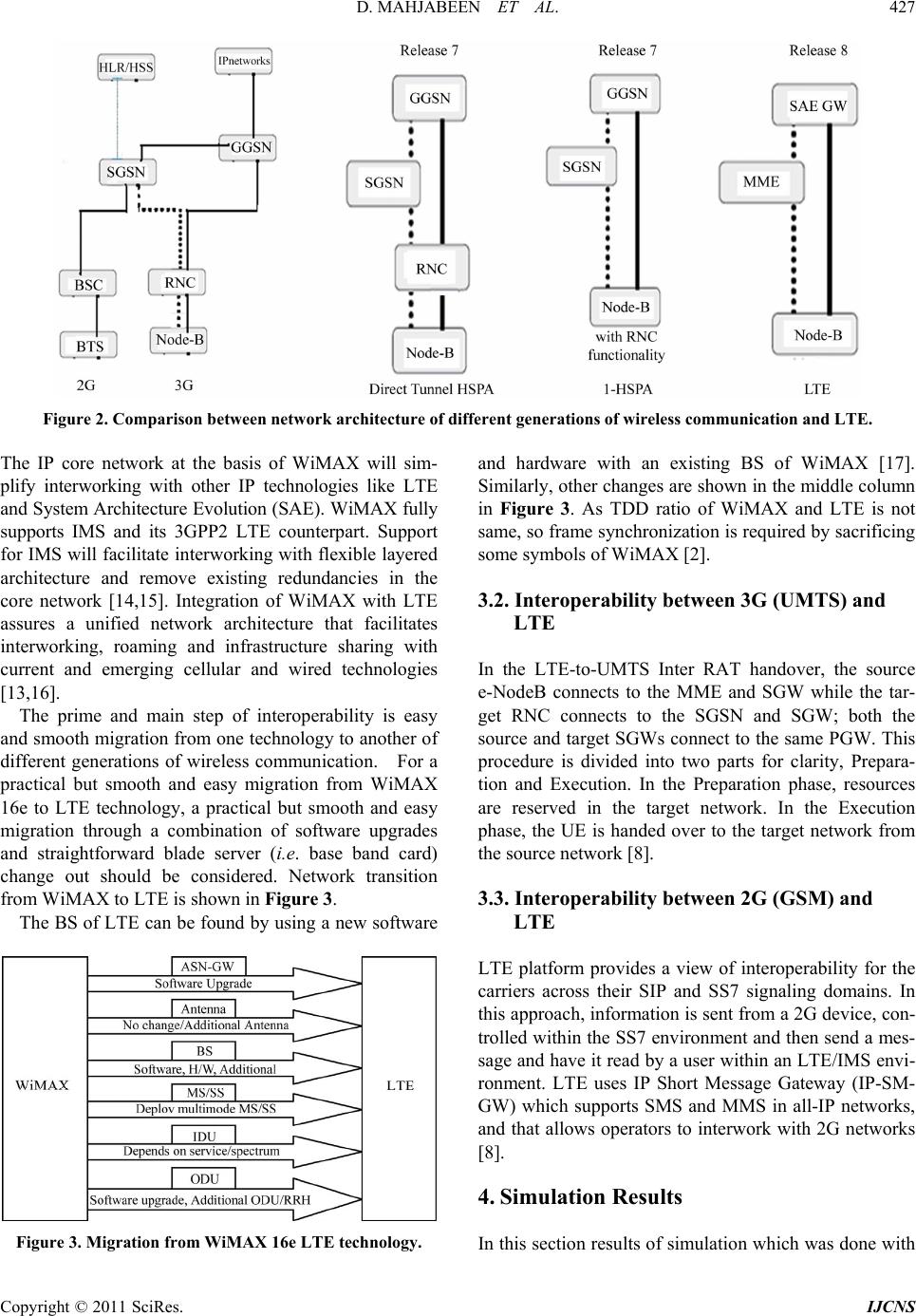 D. MAHJABEEN ET AL. Copyright © 2011 SciRes. IJCNS 427 Figure 2. Comparison between network architecture of different generations of wireless communication and LTE. The IP core network at the basis of WiMAX will sim- plify interworking with other IP technologies like LTE and System Architecture Evolution (SAE). WiMAX fully supports IMS and its 3GPP2 LTE counterpart. Support for IMS will facilitate interworking with flexible layered architecture and remove existing redundancies in the core network [14,15]. Integration of WiMAX with LTE assures a unified network architecture that facilitates interworking, roaming and infrastructure sharing with current and emerging cellular and wired technologies [13,16]. The prime and main step of interoperability is easy and smooth migration from one technology to another of different generations of wireless communication. For a practical but smooth and easy migration from WiMAX 16e to LTE technology, a practical but smooth and easy migration through a combination of software upgrades and straightforward blade server (i.e. base band card) change out should be considered. Network transition from WiMAX to LTE is shown in Figure 3. The BS of LTE can be found by using a new software Figure 3. Migration from WiMAX 16e LTE technology. and hardware with an existing BS of WiMAX [17]. Similarly, other changes are shown in the middle column in Figure 3. As TDD ratio of WiMAX and LTE is not same, so frame synchronization is required by sacrificing some symbols of WiMAX [2]. 3.2. Interoperability between 3G (UMTS) and LTE In the LTE-to-UMTS Inter RAT handover, the source e-NodeB connects to the MME and SGW while the tar- get RNC connects to the SGSN and SGW; both the source and target SGWs connect to the same PGW. This procedure is divided into two parts for clarity, Prepara- tion and Execution. In the Preparation phase, resources are reserved in the target network. In the Execution phase, the UE is handed over to the target network from the source network [8]. 3.3. Interoperability between 2G (GSM) and LTE LTE platform provides a view of interoperability for the carriers across their SIP and SS7 signaling domains. In this approach, information is sent from a 2G device, con- trolled within the SS7 env ironment and then send a mes- sage and have it read by a user within an LTE/IMS envi- ronment. LTE uses IP Short Message Gateway (IP-SM- GW) which supports SMS and MMS in all-IP networks, and that allows operators to interwork with 2G networks [8]. 4. Simulation Results In this section results of simulation which was done with 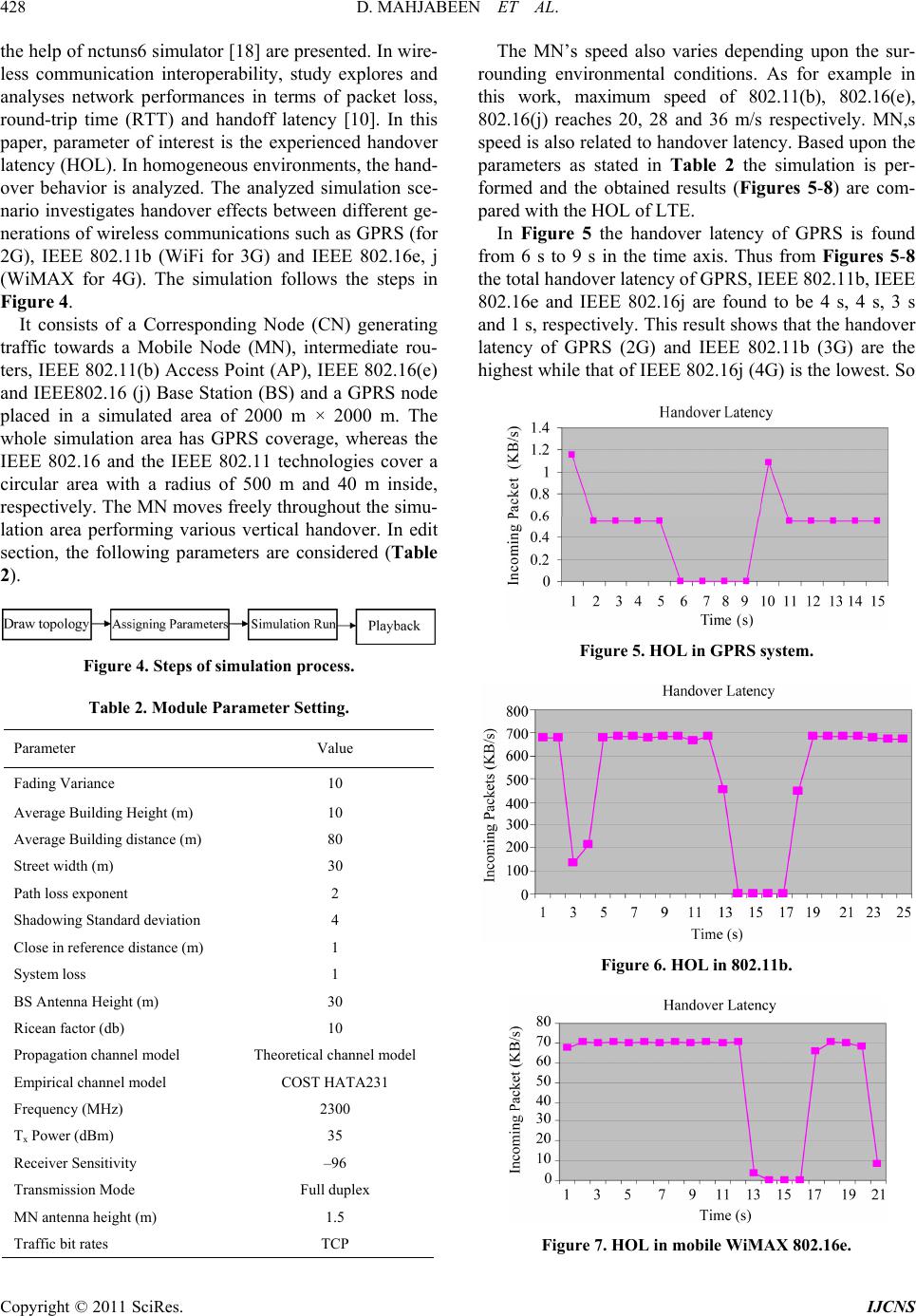 D. MAHJABEEN ET AL. Copyright © 2011 SciRes. IJCNS 428 the help of nctuns6 simulator [18] are presented. In wire- less communication interoperability, study explores and analyses network performances in terms of packet loss, round-trip time (RTT) and handoff latency [10]. In this paper, parameter of interest is the experienced handover latency (HOL). In homogeneous environments, the hand- over behavior is analyzed. The analyzed simulation sce- nario investigates handover effects between different ge- nerations of wireless communications such as GPRS (for 2G), IEEE 802.11b (WiFi for 3G) and IEEE 802.16e, j (WiMAX for 4G). The simulation follows the steps in Figure 4. It consists of a Corresponding Node (CN) generating traffic towards a Mobile Node (MN), intermediate rou- ters, IEEE 802.11(b) Access Point (AP), IEEE 802.16(e) and IEEE802.16 (j) Base Station (BS) and a GPRS node placed in a simulated area of 2000 m × 2000 m. The whole simulation area has GPRS coverage, whereas the IEEE 802.16 and the IEEE 802.11 technologies cover a circular area with a radius of 500 m and 40 m inside, respectively. The MN moves freely throughout the simu- lation area performing various vertical handover. In edit section, the following parameters are considered (Table 2). Figure 4. Steps of simulation process. Table 2. Module Paramete r Setting. Parameter Value Fading Variance 10 Average Building Height (m) 10 Average Building distance (m) 80 Street width (m) 30 Path loss exponent 2 Shadowing Standard deviation 4 Close in reference distance (m) 1 System loss 1 BS Antenna Height (m) 30 Ricean factor (db) 10 Propagation channel model Theoretical channel model Empirical channel model COST HATA231 Frequency (MHz) 2300 Tx Power (dBm) 35 Receiver Sensitivity –96 Transmission Mode Full duplex MN antenna height (m) 1.5 Traffic bit rates TCP The MN’s speed also varies depending upon the sur- rounding environmental conditions. As for example in this work, maximum speed of 802.11(b), 802.16(e), 802.16(j) reaches 20, 28 and 36 m/s respectively. MN,s speed is also related to handover latency. Based upon the parameters as stated in Table 2 the simulation is per- formed and the obtained results (Figures 5-8) are com- pared with the HOL of LTE. In Figure 5 the handover latency of GPRS is found from 6 s to 9 s in the time axis. Thus from Figures 5-8 the total handover latency of GPRS, IEEE 802.11b , IEEE 802.16e and IEEE 802.16j are found to be 4 s, 4 s, 3 s and 1 s, respectively. This result shows that the handover latency of GPRS (2G) and IEEE 802.11b (3G) are the highest while that of IEEE 802.16j (4G) is the lowest. So Figure 5. HOL in GPRS system. Figure 6. HOL in 802.11b. Figure 7. HOL in mobile WiMAX 802.16e. 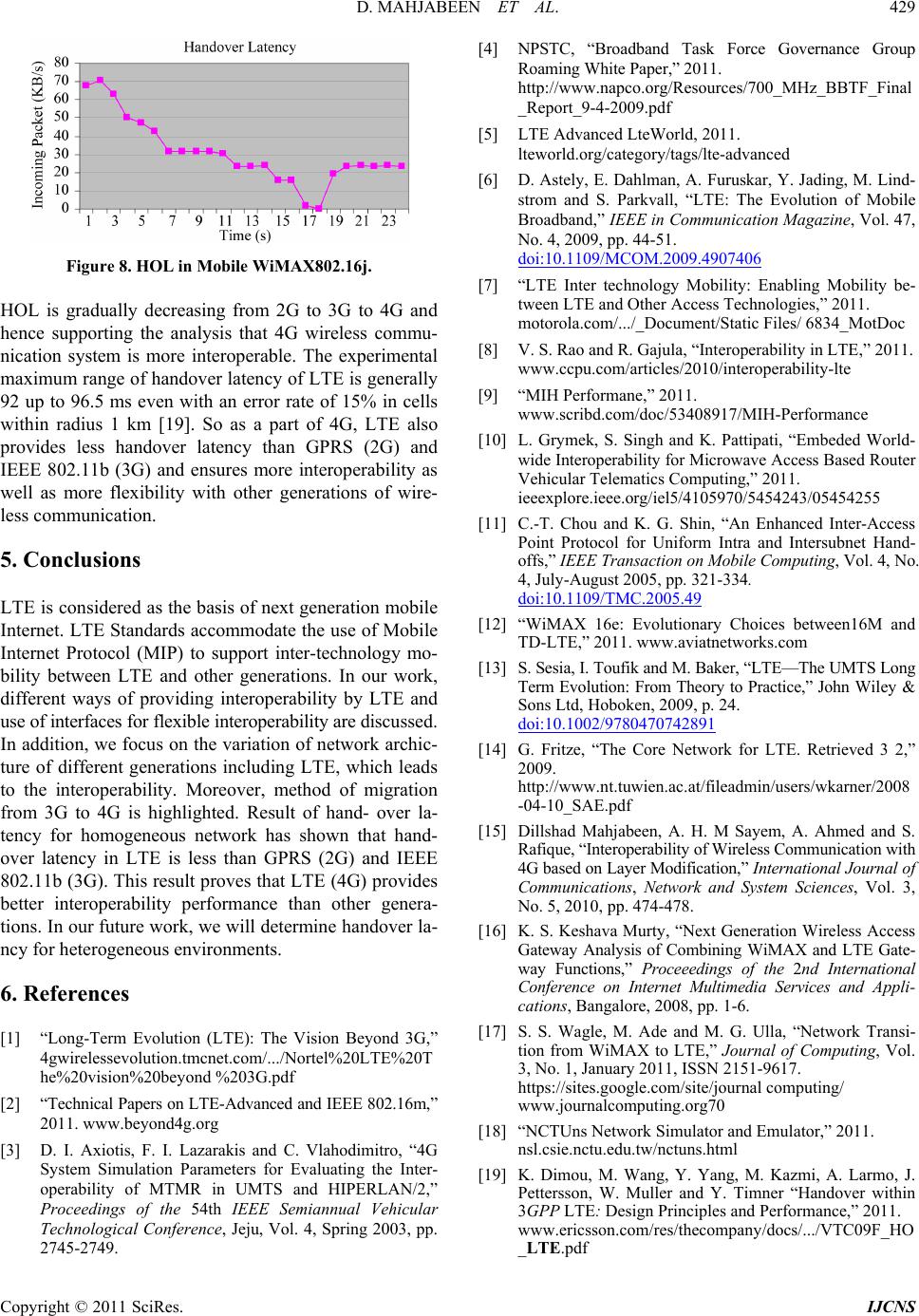 D. MAHJABEEN ET AL. Copyright © 2011 SciRes. IJCNS 429 Figure 8. HOL in Mobile WiMAX802.16j. HOL is gradually decreasing from 2G to 3G to 4G and hence supporting the analysis that 4G wireless commu- nication system is more interoperable. The experimental maximum range of handover latency of LTE is generally 92 up to 96.5 ms even with an error rate of 15% in cells within radius 1 km [19]. So as a part of 4G, LTE also provides less handover latency than GPRS (2G) and IEEE 802.11b (3G) and ensures more interoperability as well as more flexibility with other generations of wire- less communication. 5. Conclusions LTE is considered as the basis of next generation mobile Internet. LTE Standards accommodate the use of Mobile Internet Protocol (MIP) to support inter-technology mo- bility between LTE and other generations. In our work, different ways of providing interoperability by LTE and use of interfaces for flexible interoperability are discussed. In addition, we focus on the variation of n etwork archic- ture of different generations including LTE, which leads to the interoperability. Moreover, method of migration from 3G to 4G is highlighted. Result of hand- over la- tency for homogeneous network has shown that hand- over latency in LTE is less than GPRS (2G) and IEEE 802.11b (3G). Th is result proves th at LTE (4G) provides better interoperability performance than other genera- tions. In our future work, we will determine handover la- ncy for heterogeneous environments. 6. References [1] “Long-Term Evolution (LTE): The Vision Beyond 3G,” 4gwirelessevolution.tmcnet.com/.../Nortel%20LTE%20T he%20vision%20beyond %203G.pdf [2] “Technical Papers on LTE-Advanced and IEEE 802.16m,” 2011. www.beyond4g.org [3] D. I. Axiotis, F. I. Lazarakis and C. Vlahodimitro, “4G System Simulation Parameters for Evaluating the Inter- operability of MTMR in UMTS and HIPERLAN/2,” Proceedings of the 54th IEEE Semiannual Vehicular Technological Conference, Jeju, Vol. 4, Spring 2003, pp. 2745-2749. [4] NPSTC, “Broadband Task Force Governance Group Roaming White Paper,” 2011. http://www.napco.org/Resources/700_MHz_BBTF_Final _Report_9-4-2009.pdf [5] LTE Advanced LteWorld, 2011. lteworld.org/category/tags/lte-advanced [6] D. Astely, E. Dahlman, A. Furuskar, Y. Jading, M. Lind- strom and S. Parkvall, “LTE: The Evolution of Mobile Broadband,” IEEE in Communication Magazine, Vol. 47, No. 4, 2009, pp. 44-51. doi:10.1109/MCOM.2009.4907406 [7] “LTE Inter technology Mobility: Enabling Mobility be- tween LTE and Other Access Technologies,” 2011. motorola.com/.../_Document/Static Files/ 6834_MotDoc [8] V. S. Rao and R. Gajula, “Interoperability in LTE,” 2011. www.ccpu.com/articles/2010/interoperability-lte [9] “MIH Performane,” 2011. www.scribd.com/doc/53408917/MIH-Performance [10] L. Grymek, S. Singh and K. Pattipati, “Embeded World- wide Interoperability for Microwave Access Based Router Vehicular Telematics Computing,” 2011. ieeexplore.ieee.org/iel5/4105970/5454243/05454255 [11] C.-T. Chou and K. G. Shin, “An Enhanced Inter-Access Point Protocol for Uniform Intra and Intersubnet Hand- offs,” IEEE Transaction on Mobile Computing, Vol. 4, No. 4, July-August 2005, pp. 321-334. doi:10.1109/TMC.2005.49 [12] “WiMAX 16e: Evolutionary Choices between16M and TD-LTE,” 2011. www.aviatnetworks.com [13] S. Sesia, I. Toufik and M. Baker, “LTE—The UMTS Long Term Evolution: From Theory to Practice,” John Wil ey & Sons Ltd, Hoboken, 2009, p. 24. doi:10.1002/9780470742891 [14] G. Fritze, “The Core Network for LTE. Retrieved 3 2,” 2009. http://www.nt.tuwien.ac.at/fileadmin/users/wkarner/2008 -04-10_SAE.pdf [15] Dillshad Mahjabeen, A. H. M Sayem, A. Ahmed and S. Rafique, “Interoperability of Wireless Communication with 4G based on Layer Modification,” International Journal of Communications, Network and System Sciences, Vol. 3, No. 5, 2010, pp. 474-478. [16] K. S. Keshava Murty, “Next Generation Wire less Access Gateway Analysis of Combining WiMAX and LTE Gate- way Functions,” Proceeedings of the 2nd International Conference on Internet Multimedia Services and Appli- cations, Bangalore, 2008, pp. 1-6. [17] S. S. Wagle, M. Ade and M. G. Ulla, “Network Transi- tion from WiMAX to LTE,” Journal of Computing, Vol. 3, No. 1, January 2011, ISSN 2151-9617. https://sites.google. com/site/journal computing/ www.journalcomputing.org70 [18] “NCTUns Network Simulator and Emulator,” 2011. nsl.csie.nctu.edu.tw/nctuns.html [19] K. Dimou, M. Wang, Y. Yang, M. Kazmi, A. Larmo, J. Pettersson, W. Muller and Y. Timner “Handover within 3GPP LTE: Design Principles and Performance,” 2011. www.ericsson.com/res/thecompany/docs/.../ VTC09F_HO _LTE.pdf |

